With warehouse space at a premium worldwide, storage has become increasingly vertical and more compact. Goods are palletised for ease of storage and movement, wherever possible.
Melissa Barnett reports that it is no surprise that the materials handling industry's response to consumer demand has been to develop better and more innovative designs to maximise mobility, speed of loading and available space.
There are over 250 different forklift attachments available to streamline just about any materials handling function, but the increasing demands of shipping and warehousing mean that pallet-handling attachments are now seen as essential tools in any fleet.
Pallets explainedPallets are platforms used to carry bulk goods. No universally accepted standard for pallet dimensions exist and hundreds of different pallet sizes are used around the globe. While no single dimensional standard governs pallet production, a few different sizes are widely used.
The International Organisation for Standardisation (ISO) sanctions six pallet dimensions, detailed in ISO Standard 6780: Flat pallets for intercontinental materials handling-Principal dimensions and tolerances:| Dimensions, mm (W × L) | Dimensions, in (W × L) | Region most used in |
| 1219 × 1016 | 48.00 × 40.00 | North America |
| 1000 × 1200 | 39.37 × 47.24 | Europe, Asia; similar to 48x40 |
| 1165 × 1165 | 44.88 × 44.88 | Australia |
| 1067 × 1067 | 42.00 × 42.00 | North America, Europe, Asia |
| 1100 × 1100 | 43.30 × 43.30 | Asia |
| 800 × 1200 | 31.50 × 47.24 | Europe; fits many doorways |
*Table sourced from www.wikipedia.comThere is an increasing move, due to environmental and economic concerns, to pallet alternatives such as cardboard and plastic slipsheets, but for the majority of warehousing, timber pallets are still the norm. Industries with the highest use of pallet-handling are beverage, bottling, glass, cement, brick yards, construction materials, military and shipping.
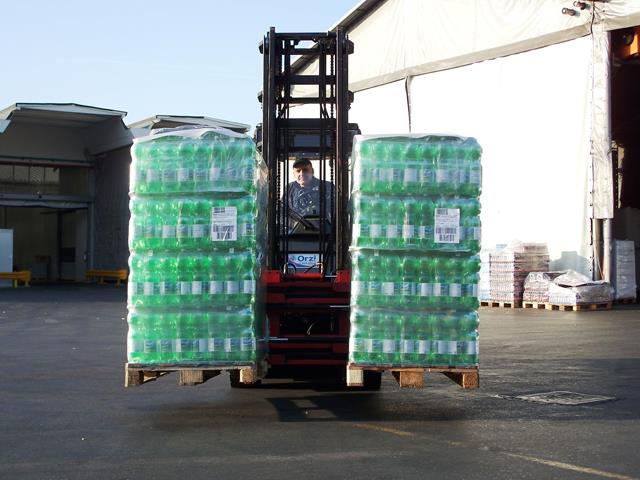 Bolzoni-Auramo 1-2 used in beverage industry |
The impetus to develop pallet-handling attachments came as a response to consumer needs for logistical efficiency, especially in light of the differences in pallet sizes and the associated difficulties. Carlo Fallarini, drector of marketing and sales for Bolzoni-Auramo, believes "the main advantage to using pallet-handling attachments is the ability to handle more load units at a time, especially in applications of high load volumes, such as beverage, breweries and building materials". He goes on to say that speeding up the loading/unloading/warehousing operations increases handling productivity and reduces the number of forklifts used in the operation.
Pallet attachments have not only provided logistical efficiencies but have also improved driver comfort and safety. Drivers no longer need to step out of the forklift in all kinds of weather to adjust fork widths. Because pallet-handling attachments are operated hydraulically, they also reduce the risk of back and hand injuries. Driver fatigue is reduced due to a reduction in loading/unloading time and there is less damage to stock due to more accurate alignment of forks.
Three of the most popularThe three most popular pallet-handling attachments, according to David Chen of Microlift, are sideshifters, fork positioners and multi-pallet-handlers. There are also a number of companies around the world that manufacture specialised pallet-handling attachments for niche requirements.
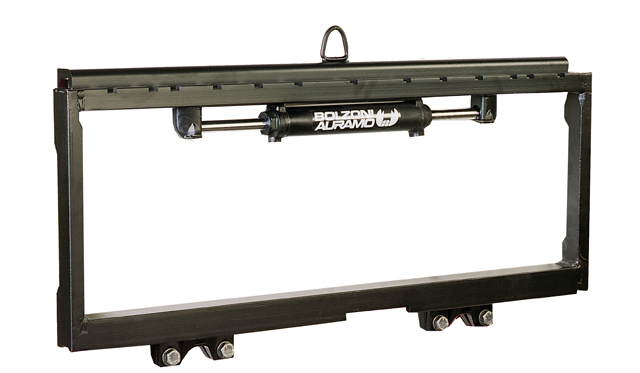 Sideshifter |
SideshiftersSideshifters are the original pallet-handling innovation and these days are almost considered standard by most OEMs. Mounted on the front of a conventional forklift, sideshifters allow fixed forks to move a load from side to side, improving manoeuvrability, reducing loading times by improved access to spaces and reducing stock damage due to more accurate positioning of forks.
Cascade Corporation also claims that sideshifters reduce wear and tear on tyres and parts, especially in transit vehicles because there is less manoeuvring done during loading/unloading cycles.
Sideshifters are available in both integrated or hook-on designs. According to Paul Romjin of Axtra Voorzetapparatuur BV which specialises in reconditioning forklift attachments, sideshifters are never reconditioned because they are so cheap to buy. German attachment manufacturer Stabau currently only manufactures sideshifters for specialised applications, such as dirty, heavy-duty or hot applications like foundries and forging shops, because it sees sideshifters as a standard piece of materials handling equipment.
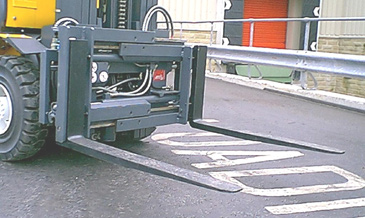 Fork positioner |
Fork positionersAccording to Neil Adlam, group manager at EMC, fork positioners are taking over from sideshifters. Fallarini of Bolzoni-Araumo believes that safety regulations and driver comfort are the two main reasons for their increased adoption rate over the past 10 years.
Standard forks on a carriage have to be manually adjusted to fit an array of pallet sizes and dimensions and over the period of a day, the operator may have to disembark countless times to adjust for load. Fork positioners allow forks to be hydraulically adjusted along a frame to fit most standard loads, enabling the operator to handle various pallet sizes quickly and efficiently while remaining seated.
Fork positioners come in various frame sizes up to 1.8m and can be used to lift weights of up to 16 tons. They can be integrated or hook on and can be attached to existing sideshifter frames. Most attachment manufacturers have a number of options available.
While most fork positioners are operated by hydraulic hoses and reels, a number of manufacturers including Microlift and Cascade have developed wireless control forklift positioners. Cascade's K-series fork positioners are radio frequency-driven, doing away with hydraulic hoses and reels and improving visibility.
Fork positioners can be adapted to both light and heavy industry. Stefan Pinter, export sales manager for Stabau, Schulte-Henke GmbH, has seen a trend among customers for a lighter design "in order to have the benefits of improved driver visibility and technical data and to improve the residual load capacity of the lift truck". Inspired by this trend, Stabau has designed the ZVP series for 'light' application environments such as logistics centres. The ZVP and ZVP-S are profile-guided with an integral synchronous travel system.
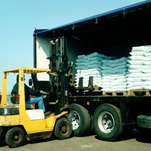 MSE-Forks telescopic pallet handler |
Stabau and MSE-Forks also produce a range of telescopic positioners, enabling one-sided unloading of trucks in warehouses with narrow aisles and deep racks. The forks can be retracted or extended up to 2 metres to avoid damage to pallet stock. Folkert De Graaf, sales and marketing manager for MSE-Forks, says that the combination of telescopic forks on sideshifters and fork positioners is becoming very common.
Stabau's S11-ZV80TG has a telescopic range of 1.25 metres and width of 2 metres, while MSE-Forks has developed a microthin, 40mm telescopic fork for use with pallets with limited pallet insert openings.
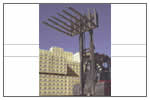 Unit Load Handling System's haevy duty multi-handler |
Double and multi-pallet handlersFallarini believes multi-pallet handlers "are the perfect combination between customer needs and technological proposal". Multi-pallet handlers are fork positioning attachments designed to handle one or more pallets at a time. Configurations range from the standard 1-2, such as Bolzoni-Auramo's Model DS, to 1-2-3, 2-4, and 2-3-4 options. Multi-pallet handlers offer the best way of minimising the space required to load and unload trucks, particularly in the beverage, brewery and building materials industries. De Graaf also believes they are invaluable in large warehouse spaces where "handling more pallets at a time is becoming more popular because the spaces are getting bigger and (there are) more kilometres the forklift needs to travel in each load cycle". Fallarini calculates that by using a 1-2 multi-pallet handler, handling time can be reduced by up to 50%, resulting in a substantial increase in productivity.
Many believe that multi-pallet handlers give excellent and rapid return on investment. "The ROI for multi-pallet handlers," says Adlam "is easily justified. The productivity, reduced maintenance, reduced equipment and personnel required, not to mention the associated costs, easily justify the initial increase in investment required for multi-pallet handling." Bolzoni-Auramo's calculation of ROI on the use of a 1-2 multi-pallet handler instead of standard forks is only 18 months.
Because many manufacturers see multi-pallet handlers as the way of the future, investment in innovation has been substantial. Bolzoni-Auramo will soon release a profiles-guided 1-2 pallet-handler and a shaft-guided model for larger machines. A special 1-2-3 pallet-handler has already been developed for heavy-duty applications and includes an optional self-lubricating system to ease maintenance and reduce operational costs.
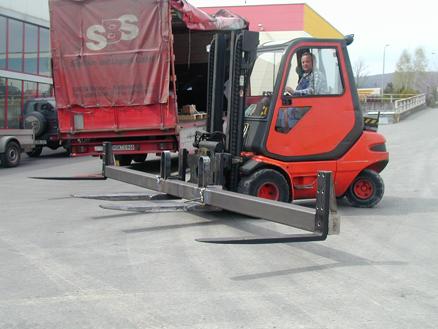 Stabau long pallet load handler |
Multi-pallet handlers can be very application specific. EMC has been working with Toyota Materials Handling and CSR lightweight systems to offer a multi-pallet handler that can be used for handling wide plaster board packs and standard 1,170mm Australian shipping pallets. "This has given CSR the versatility to reduce the total number of forklifts required and maximise their use of their larger forklifts," says Adlam.
Unit Load Handling Systems has developed a multi-pallet handler that works on specialised pallets or widely spaced pallets under long loads, as well as high-capacity fork extensions used to load two pallets at a time across the bed of a trailer or to reach pallets unreachable with standard forklift forks.
What else can you get?A number of companies manufacture pallet-handling equipment for specific, niche industry needs, with interesting results. Bremco, an Australian manufacturing company, has designed a scissorlift device for use with forks and pallets. The BMP057 Palift resembles a scissor table with a top deck and a base connected by a pair of scissor legs. The levelling mechanism is a set of springs set to the weight and height of the product. A shock absorber is used to prevent any bounce. The unit rotates continuously in both directions, reducing time required to walk around pallets, and is great for loading goods fast onto and from standard pallets. The Palift reduces stretching required when loading products, reducing injury.
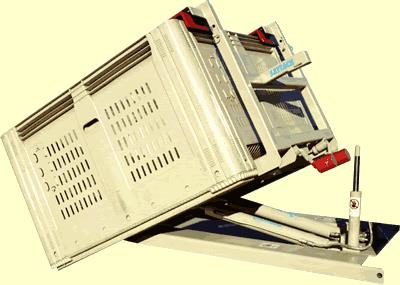 EMC pallet-bin tipper |
Bremco also manufactures the AIM forward bin-tipper, an attachment designed to empty pallet bin containers in a controlled manner regardless of contents. The system uses a quick-hitch hydraulic attachment to enable the operator to use the existing levers to control the dispatching of product from the pallet bin.
There is no doubt that in a world where floor space is at a premium and product storage and handling must be as time- and energy-efficient as possible to maximise costs and minimise damage, pallets will continue to rule, and while they do, pallet-handling attachments will continue to be invaluable innovations in the marketplace.